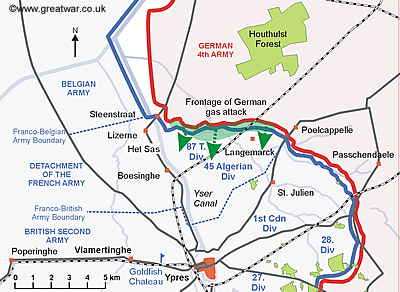 Installation of the gas cylinders completed
Installation of the gas cylinders completed
11 April 1915
Six days after starting preparations to install gas cylinders (codenamed “F-Batteries”) in the alternative trial sector Oberst Peterson and his special pioneer units had dug 5,730 gas cylinders into position. By night and in bad weather the canisters had been dragged into the front line trenches on a frontage of 6 kilometres. The front of the attack was to start a few hundred metres east of Langemarck and continue to the Yser canal at Steenstraat.

The gas cylinders were installed in groups of twenty cylinders per “battery”. In total 180,000 kilograms of chlorine were to be released here and the flow of gas was to last five minutes. A constant danger to the gas pioneers was that enemy artillery shells might smash the cylinders and release the gas. This would not only injure the German troops nearby but it would probably alert the enemy to what was being prepared.
In order to protect the men from the chlorine gas a protective liquid (“Schutzflüssigkeit”) was distributed to the troops. It was a 30% sodium sulphate solution.(1) It was to be poured onto a pad of cotton waste and pressed against the mouth and nose. The men called the mouth pad a “Riechpäckchen”. According to the regimental history of 210. Reserve-Infanterie-Regiment this primitive gas mask was sufficient at the time because the chlorine gas tended to blow away quickly across open ground.
However, for several days after 11th April when the cylinders were ready to be used the wind did not blow in the right direction here either.
Next>> Aims of the German Supreme Command
Acknowledgements
(1) Natriumthiosulfatflösung (Geschichte des Reserve-Infanterie-Regiments Nr. 210, p. 54)